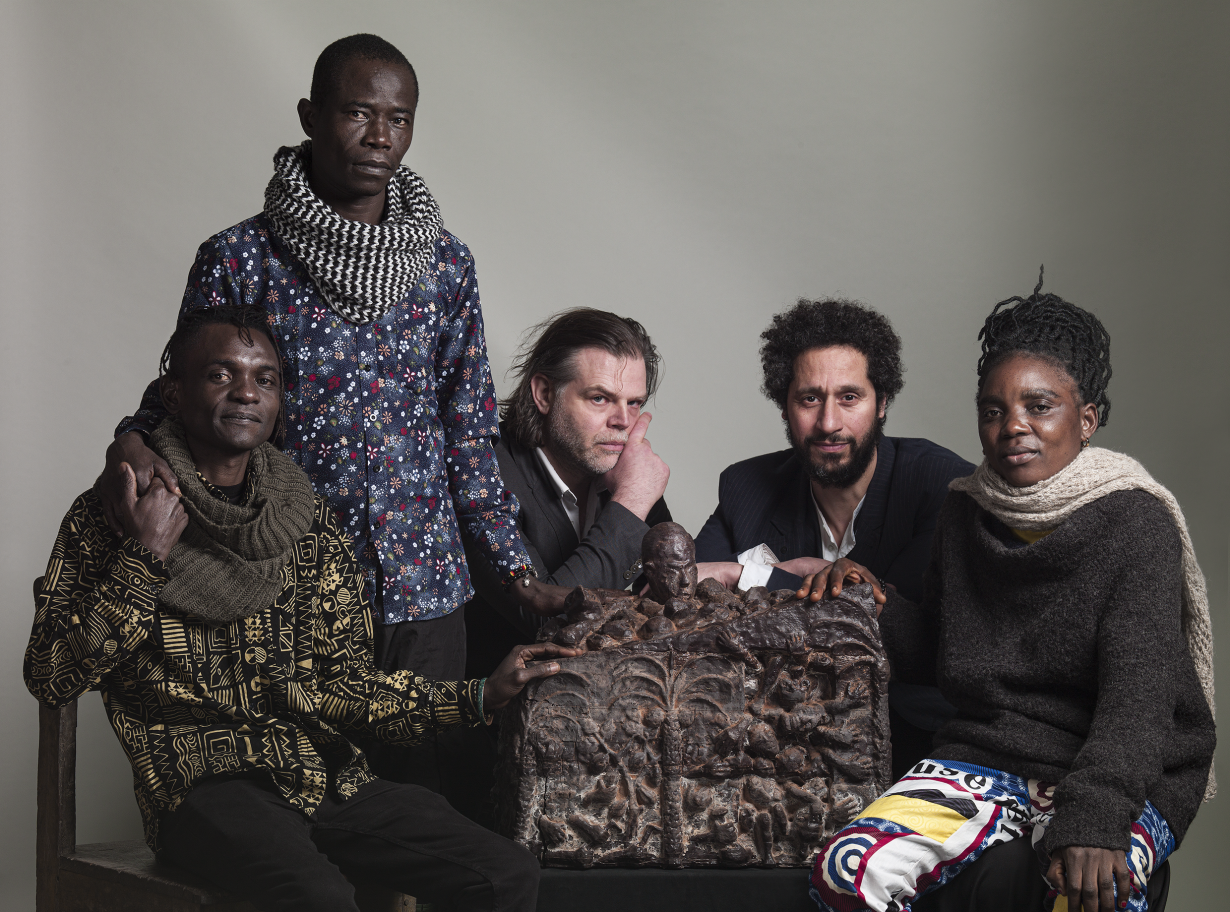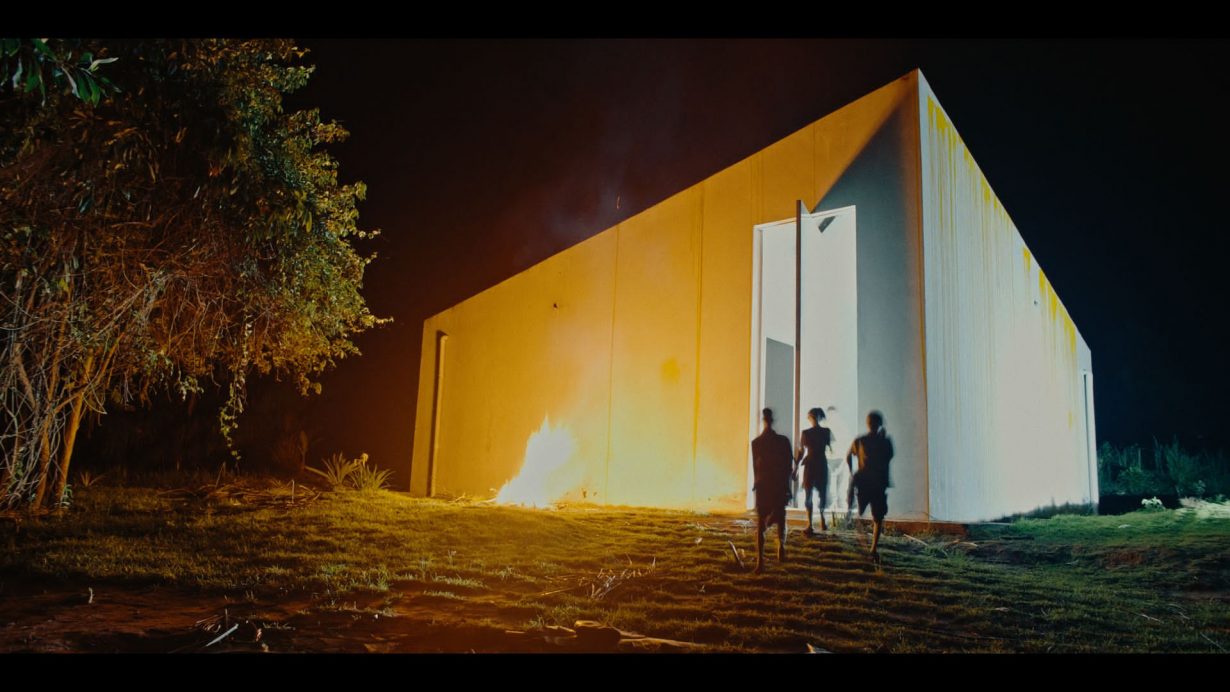ArtReview sent a questionnaire to artists and curators exhibiting in and curating the various national pavilions of the 2024 Venice Biennale, the responses to which will be published daily in the leadup to and during the Venice Biennale, which runs from 20 April – 24 November.
The Congolese artist collective Cercle d’Art des Travailleurs de Plantation Congolaise (CATPC) is representing The Netherlands, supported by artist Renzo Martens and curator Hicham Khalidi; the pavilion is in the Giardini.

ArtReview What do you think of when you think of Venice?
CATPC We see a gathering of white cubes, museums, all beneficiaries and perpetrators of the sweat and blood of humans on plantations. We see a shrine to art that sneaks in every two years without the participation of the people who have unwittingly funded it, and who don’t even know it exists.
We see this gathering of museums as a ‘sacred festival’ of art that is intended only for a certain type of ‘religious’: artists, curators and a public that has access to these networks, and not others. This event is not open to those who have financed it, only to a privileged few in the world and sometimes, rarely, to a lucky or very hard-working African elite, who manage, if they can, to get in to put on a show and then disappear.
AR What can you tell us about your exhibition plans for Venice?
CATPC We call our participation in and contribution to this biennale The international festival of blasphemy of the sacred. It’s a first for the plantation workers that we are and represent in the Congo and elsewhere, to be able to take part in a pavilion in Venice and get our message across, to express ourselves through art. For us, it is an unhealthy privilege to take part in a festival that is not intended for people like us.
We, the plantation workers of Lusanga, have decided to make art and solve the ills of our society by thinking and acting for ourselves. The proceeds from the sale of our art have enabled us to buy back 200 hectares of exhausted plantation land, which we are then transforming into sacred forest, which spiritually and practically gives life.
We’re moving from a monoculture where people work and keep quiet to a polyculture where art is the gateway for us. So we’re moving from the ruined plantation to the post-plantation era.
Our community of artists, which is also a cooperative, has opted to gallery together, work together and share all our income together, whether in art or in the agroforestry that we have set up. We are fighting against monoculture, against global warming, which is already threatening humanity, and above all against malnutrition in Lusanga and the surrounding area.
Lusanga was renamed Leverville in 1911, and became the hub of all the Unilever plantations in the Congo, which supplied palm oil from which museums in England were built and financed: The Lady Lever Gallery, the Unilever Series at Tate Modern, and even academic research at the Leverhulme Foundation. Profits from these plantations still go to London.
The natural and harmonious connection we are reestablishing with our land is sacred, the very forest that grows there is sacred. It is this sacredness that we want to share with the world of luxury and comfort whose foundations are supported by human lives converted into slaves –until now – to ensure that white cubes are built, and to ensure every cup of latte and chocolate can be consumed every morning in the West.
Our conscious presence to take part in an event that excludes people like us, the plantation workers, is not just to put on a good show. We are using this invitation to link it to our long-standing cause:
Liberate the plantations in Congo, liberate the land and also liberate art.
AR Why is the Venice Biennale still important, if at all? And what is the importance of showing there? Is it about visibility, inclusion, acknowledgement?
CATPC The Biennale is important because it reaches a large world that needs to know the truth, the truth that shows the contribution of plantations to the very existence of the white cube, and here it is like a gathering of nationalised and politicised cubes.
Our participation will be the reparation of a long-standing injustice, where plantation workers will also once again be able to benefit from those ‘unhealthy privileges’ of which they are at the origin. All the cubes in the world have come together, and this is the chance for the White Cube Judgement (one of our works) to make sense.
The plantation workers who are not yet tainted by luxury, by comfort on the backs of others in the artistic El Dorado, to which only a few have access, those with access to the North in particular, and which leaves others – who might be more legitimate – outside. We will use these unhealthy privileges to reestablish our sacred forest on the liberated plantations.

AR When you make artworks do you have a specific audience in mind?
CATPC We don’t have a specific audience in mind. We create because our ancestors already did. Our creations send a message to the people of today and tomorrow, from Lusanga to Lubumbashi via Kinshasa. From Lusanga to Venice via Richmond (where the VMFA is based, the museum that owns the ‘Balot’ sculpture).
Our works speak to everyone without exception. They are about humanity in short.
AR Do you think there is such a thing as national art? Or is all art universal? Is there something that defines your nation’s artistic traditions? And what is misunderstood or forgotten about your nation’s art history?
CATPC No, art is not limited to something national. Otherwise the Pende works that were looted and taken to Europe would not have served as inspiration for Picasso.
Art is universal, yes. It’s only in art that we can find the ‘colours’ united in harmony. Where black and white are just matter that complement each other with red or yellow to create a single magnificent work. Art belongs to everyone, without exception.
That’s why we want to see museums on plantations too. It’s the only way to make it universal, in my opinion.
Otherwise people like us will always need to travel to the globalised cities, especially in the North, to take part in these apartheid art festivals. Our very participation would be frowned upon by our fellows on the plantations, who have no access to these events to which they have nonetheless, through their work on the plantations, involuntarily contributed. This is why our museum, our Congolese Pavilion in Lusanga, has been unified or ‘twinned’ with the Dutch Pavilion in Venice, so that everyone can take part in this event, which is supposed to be global.
AR If someone were to visit your nation, what three things would you recommend they see or read in order to understand it better?
CATPC Charity begins at home: the person we’re inviting should first come to our house in Lusanga, on the post-plantation estate, built on the ruins of the Unilever monoculture plantations, where we’ll tell them about the history of our country.
Then they will go to Boma, the first capital of the Congo as a country; they will go to the prison in Lubumbashi where Kimbangu was imprisoned, the prophet who predicted the independence of the Congo and who was imprisoned for 30 years for his words and beliefs.
Then there was the Stade du 20 Mai, also known as the Stade Tata Raphaël, where in 1974 the boxing match of the century between Muhamed Ali and Georges Foreman took place under the benevolent eye of ‘King’ Mobutu, the man the West placed on a throne made of clay, the same man who betrayed and toppled Lumumba, the Hero of the People.
‘Ali, boma ye’ (Ali kills him) is the people’s song that lives on in the streets of Kinshasa, the capital formerly known as Léopoldville, a colonial name that was replaced after independence, like all the other towns in the country that bore European names reminiscent of the dark, shameful and sad period of colonisation.
AR Which other artists have influenced or inspired you?
CATPC In the country: the courage and strength of my colleague Matthieu Kasiama inspired me a lot; the curator and owner of the secret art museum in Gungu, Aristotle Kibala, taught me a lot; the artist Jean Katambayi from Lubumbashi also inspired me; the painters Chéri Samba and Chéri Cherin, inspired me a lot; the sculptor and teacher Master Liyolo; and Papa Wemba, the singer of Rumba, who was also in the cinema and a little later revealed and developed painting talents.
Outside the country, there are: Theaster Gates, Ibrahim Mahama, Ai Weiwei with whom we exhibited at the Mori art Museum in Tokyo in 2018, where I had the honour of discovering his work. I also discovered and appreciated the work of Yoko Ono and John Lennon, War IS Over.
AR What, other than your own work, are you looking forward to seeing while you are in Venice?
CATPC We’re going to see the Benin Pavilion. We’re also interested in Egypt and South Africa. And of course the Congolese Pavilion, which we only heard about at the last minute. We didn’t know whether the D.R. Congo would also be represented this year. We’ll be there too.
The 60th Venice Biennale, 20 April – 24 November